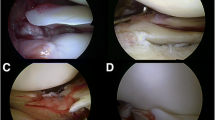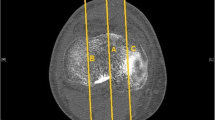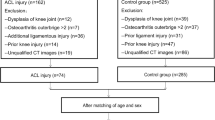Abstract
Introduction
Anterior cruciate ligament tears are one of the most frequent soft tissue injuries of the knee. A torn anterior cruciate ligament leaves the knee joint unstable and at risk for further damage to other soft tissues manifested as pain, dislocation, and osteoarthritis. A better understanding of the anatomical details of knee joints suffering anterior cruciate ligament tears is needed to understand and develop prediction models for anterior cruciate ligament injury and/or tear.
Materials and methods
Magnetic resonance images of 32 patients with anterior cruciate ligament tears and 40 patients with non-tears were evaluated from a physician group practice. Digital measurements of femoral condyle length, femoral notch width, anterior cruciate ligament width in the frontal and sagittal plane, and the anterior cruciate ligament length in the sagittal plane were taken in both groups to identify trends. Monte Carlo simulations were performed (n = 2000) to evaluate the relationship between notch width index and sagittal width and to establish functional relationships among the anatomical parameters for potential injury risk. Sensitivity analysis performed shows the risk of anterior cruciate ligament injury a function of force and notch width index.
Results
Females have a significantly shorter anterior cruciate ligament when compared to that of males. The notch width index was also significantly different between torn and non-torn individuals. The NWI was not significantly different between genders (p value = 0.40).
Conclusions
Anterior cruciate ligament injury has been shown to be caused by the forces which act on the ligament. These forces can result from hyperextension of the tibia or the internal rotation of tibia. The anatomical parameters of the knee joint (i.e., notch width index, anterior cruciate ligament width and length) have no role in the cause of an injury.








Similar content being viewed by others
References
Daniel DM, Stone ML, Dobson BE et al (1994) Fate of the ACL-injured patient. A prospective outcome study. Am J Sports Med 22:632–644
Ferretti A, Conteduca F, De Carli A et al (1991) Osteoarthritis of the knee after ACL reconstruction. Int Orthop 15:367–371
Fithian DC, Paxton EW, Stone ML et al (2005) Prospective trial of a treatment algorithm for the management of the anterior cruciate ligament-injured knee. Am J Sports Med 33:335–346
Lohmander LS, Ostenberg A, Englund M, Roos H (2004) High prevalence of knee osteoarthritis, pain, and functional limitations in female soccer players twelve years after anterior cruciate ligament injury. Arthritis Rheum 50:3145–3152
Myklebust G, Bahr R (2005) Return to play guidelines after anterior cruciate ligament surgery. Br J Sports Med 39:127–131
von Porat A, Roos EM, Roos H (2004) High prevalence of osteoarthritis 14 years after an anterior cruciate ligament tear in male soccer players: a study of radiographic and patient relevant outcomes. Ann Rheum Dis 63:269–273
Centers for Disease Control and Prevention, National Center for Health Statistics, National Hospital Discharge Survey. 1996
Anderson AF, Lipscomb AB, Liudahl KJ, Addlestone RB (1987) Analysis of the intercondylar notch by computed tomography. Am J Sports Med 15:547–552
LaPrade RF, Burnett QM (1994) 2nd, Femoral intercondylar notch stenosis and correlation to anterior cruciate ligament injuries. A prospective study. Am J Sports Med 22:198–202 (discussion 203)
Souryal TO, Freeman TR (1993) Intercondylar notch size and anterior cruciate ligament injuries in athletes. A prospective study. Am J Sports Med 21:535–539
Souryal TO, Moore HA, Evans JP (1988) Bilaterality in anterior cruciate ligament injuries: associated intercondylar notch stenosis. Am J Sports Med 16:449–454
Davis TJ, Shelbourne KD, Klootwyk TE (1999) Correlation of the intercondylar notch width of the femur to the width of the anterior and posterior cruciate ligaments. Knee Surg Sports Traumatol Arthrosc 7:209–214
Anderson AF, Dome DC, Gautam S et al., Correlation of anthropometric measurements, strength, anterior cruciate ligament size, and intercondylar notch characteristics to sex differences in anterior cruciate ligament tear rates. Am.J.Sports Med. 2001; 29 58-66
Charlton WP, St John TA, Ciccotti MG et al (2002) Differences in femoral notch anatomy between men and women: a magnetic resonance imaging study. Am J Sports Med. 30:329–333
Muneta T, Takakuda K, Yamamoto H (1997) Intercondylar notch width and its relation to the configuration and cross-sectional area of the anterior cruciate ligament. A cadaveric knee study. Am J Sports Med 25:69–72
Hewett TE, Paterno MV, Myer GD (2002) Strategies for enhancing proprioception and neuromuscular control of the knee. Clin Orthop Relat Res 402:76–94
Shelbourne KD, Facibene WA, Hunt JJ (1997) Radiographic and intraoperative intercondylar notch width measurements in men and women with unilateral and bilateral anterior cruciate ligament tears. Knee Surg Sports Traumatol Arthrosc 5:229–233
Cohen SB, VanBeek C, Starman JS et al. (2009) MRI measurement of the 2 bundles of the normal anterior cruciate ligament. Orthopedics 32
Chandrashekar N, Slauterbeck J, Hashemi J (2009) Re: Sex-based differences in the anthropometric characteristics of the anterior cruciate ligament and its relation to intercondylar notch geometry: a cadaveric study. Am J Sports Med 37:423
Dienst M, Schneider G, Altmeyer K et al (2007) Correlation of intercondylar notch cross sections to the ACL size: a high resolution MR tomographic in vivo analysis. Arch Orthop Trauma Surg 127:253–260
Park HS, Wilson NA, Zhang LQ (2008) Gender differences in passive knee biomechanical properties in tibial rotation. J Orthop Res 26:937–944
Fitzgerald SW, Remer EM, Friedman H, Rogers LF, Hendrix RW, Schafer MF (1993) MR evaluation of the anterior cruciate ligament: value of supplementing sagittal images with coronal and axial images. AJR Am J Roentgenol 160(6):1233–1237
Lee SY, Matsui N, Yoshida K (2005) Magnetic resonance delineation of the anterior cruciate ligament of the knee: flexed knee position within a surface coil. Clin Imaging 29(2):117–122
Domzalski M, Grzelak P, Gabos P (2010) Risk factors for anterior cruciate ligament injury in skeletally immature patients: analysis of intercondylar notch width using magnetic resonance imaging. Int Orthop 34(5):703–707
Davis TJ, Shelbourne KD, Klootwyk TE (1999) Correlation of the intercondylar notch width of the femur to the width of the anterior and posterior cruciate ligaments. Knee Surg Sports Traumatol Arthrosc 7(4):209–214
Woo SL, Hollis JM, Adams DJ, Lyon RM, Takai S (1991) Tensile properties of the human femur-anterior cruciate ligament-tibia complex. The effects of age and orientation. Am J Sports Med 19:217–225
Kanamori A, Woo SL, Ma CB, Zeminski J, Rudy TW, Li G, Livesay GA (2000) The forces in the anterior cruciate ligament and knee kinematics during a simulated pivot shift test: a human cadaveric study using robotic technology. Arthroscopy 16:633–639
Stein V, Li L, Guermazi A, Zhang Y, Kwoh CK, Eaton CB, Hunter DJ (2010) The relation of femoral notch stenosis to ACL tears in persons with knee osteoarthritis. Osteoarthritis Cartilage 18(2):192–199
Author information
Authors and Affiliations
Corresponding author
Ethics declarations
Conflict of interest
No potential conflicts of interest have been identified.
Rights and permissions
About this article
Cite this article
Estes, K., Cheruvu, B., Lawless, M. et al. Risk assessment for anterior cruciate ligament injury. Arch Orthop Trauma Surg 135, 1437–1443 (2015). https://doi.org/10.1007/s00402-015-2292-9
Received:
Published:
Issue Date:
DOI: https://doi.org/10.1007/s00402-015-2292-9




